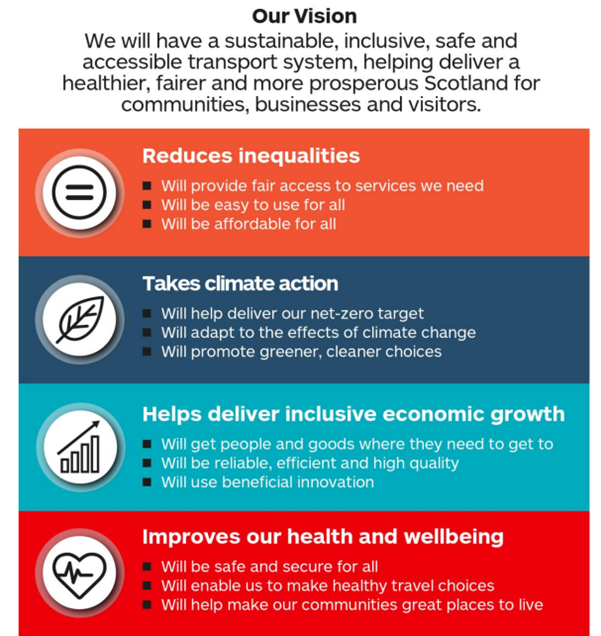Fourth Delivery Plan: Introduction
This NTS Delivery Plan sets out the range of actions the Scottish Government will take until the end of 2025 to support the delivery of a sustainable, safe, inclusive, resilient transport system that meets the needs of individuals, businesses and visitors, and is accessible to all.
Vision, Priorities, Outcomes and Policies
The vision for transport is underpinned by four priorities, each with three associated outcomes. The vision, priorities and outcomes are at the heart of the NTS and are the basis upon which we take decisions and evaluate the success of Scotland’s transport policies going forward.

A range of strategic policies were also developed to drive change and address the challenges, in order to achieve the priorities and outcomes, and deliver the vision. The policies are high-level statements of intent and are presented throughout the document under the outcomes. Under these, sit specific actions. Impact assessments for each action are carried out during the policy, project and programme development stage.
This Delivery Plan sets out the actions being taken by the Scottish Government in relation to the NTS. It does not cover actions being taken by the wider public, private and third sector in Scotland, all of which work to progress the overall vision. This is in the context of the transport sector as a whole, supporting over 150,000 full-time equivalent jobs and being around 7-8% of Scottish Gross Value Added and employment. Our actions in maintaining and enhancing the transport system help to ensure the benefits of the economic activity, that they are instrumental in generating, can be enjoyed by the people of Scotland, through the ability to access leisure and social opportunities. A separate report on the Value of Transport to the Economy is due to be published in early-2025.
We have attempted to group the actions we are taking under specific themes, but the majority of the actions contribute to more than one of the strategic priorities.
The information within this Delivery Plan is correct as of 10 December 2024, and this plan runs until the end of 2025.
Engagement
Delivering the vision remains a shared endeavour, with responsibilities across the Scottish Government, operators, local authorities, business, industry and users. This approach to collaboration was key to the development of the NTS at its outset and remains at the heart of our day-to-day working.
The Cabinet Secretary for Transport co-chairs the NTS Delivery Board, alongside the Convention of Scottish Local Authorities (COSLA). The Board brings together a number of organisations who hold a statutory responsibility for delivery of the NTS.
We also engage with a range of organisations on equality issues, and this year, the Transport Equality Group was established, which includes representation from BEMIS, Scottish Youth Parliament, Mobility and Access Committee for Scotland, Engender and Age Scotland.
To support the Inclusive Economic Growth priority at the strategic level, we engage with a range of businesses and industry through the Transport Business Group. This group includes Logistics UK, VisitScotland, Scottish Enterprise, Airport Operators Association and the Rail Freight Group.
Rural issues, specifically, are addressed through a Ministerial working group convened to take forward development of the Rural Delivery Plan by 2026. We also engage with the Convention of the South of Scotland (COSS) and the Convention of the Highlands and Islands (COHI), participating in bi-annual events, each attended by a number of key regional partners.
Engagement at policy level is carried out across Transport Scotland and Scottish Government, and we would like to thank all of our partners and stakeholders for the hard work over the past year and continue to look forward to working together in 2025.
Monitoring
In 2021, we published the NTS Monitoring and Evaluation framework, which highlights headline and secondary indicators that we routinely monitor and report on. In 2022, the baseline for these indicators was published, drawing on data from 2019 - the last full year prior to the NTS’ implementation. The indicators reflect the NTS’ four priorities and are designed to provide measures of progress. We will produce three-yearly reports on progress, with the first report against this baseline published on 19 December 2024.
Annually, we also publish statistics, which report on the monitoring and evaluation indicators. This includes the number of people who reported walking or cycling over the past seven days or who used the bus over the last month; tonnes of greenhouse gas equivalent emitted by the transport sector over the most recent year for which data are available, broken down by mode. We have measures for how easy it is to get to work and school, by public transport. These results are broken down, where possible, by protected characteristic, socioeconomic status and geography.
We continue to report on existing targets and strategic objectives, such as achieving net zero by 2045 and our road safety targets.
Fiscal Constraints
The Scottish Government has faced the most challenging financial situation since devolution, as a result of unprecedented economic pressures, following the pandemic and the cost-of-living crisis. Transport is particularly impacted by these challenges, given its exposure to energy price and construction sector inflation, as well as pay and ongoing patronage recovery following COVID-19, on the public transport network. It is within this difficult landscape that we have had to take tough decisions to prioritise work that will most effectively deliver on our commitments.
Despite these ongoing challenges, we are focusing on delivering on the NTS priorities, operating and maintaining a transport system that everyone needs, and progressing the First Minister’s stated missions of eradicating child poverty, growing the economy, tackling the climate emergency and of improving public services.